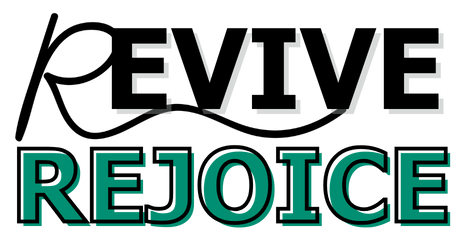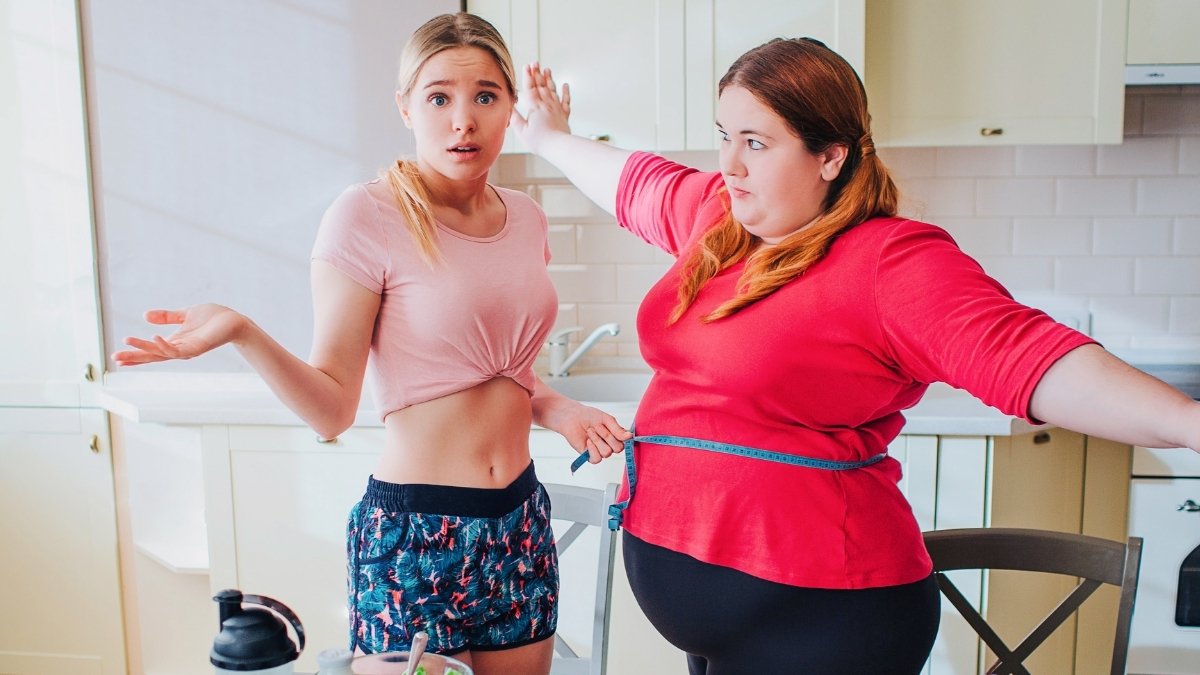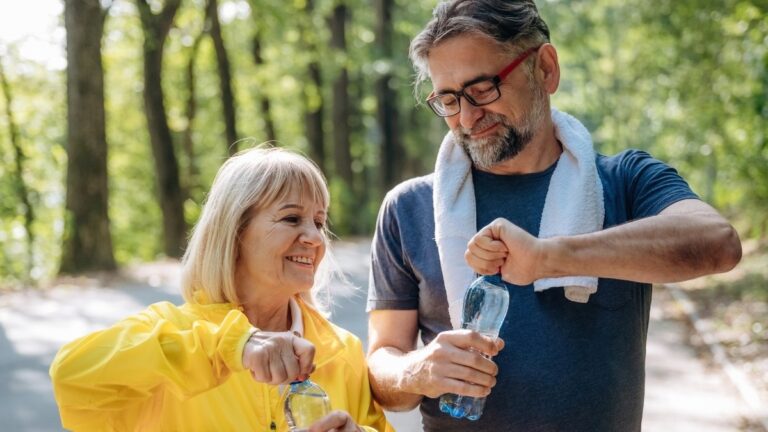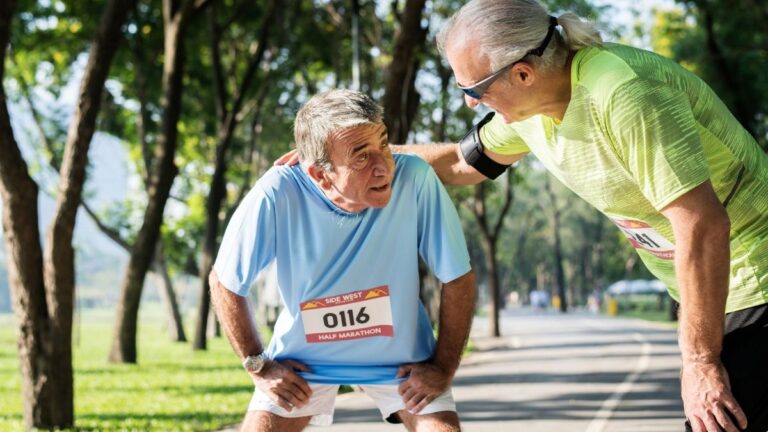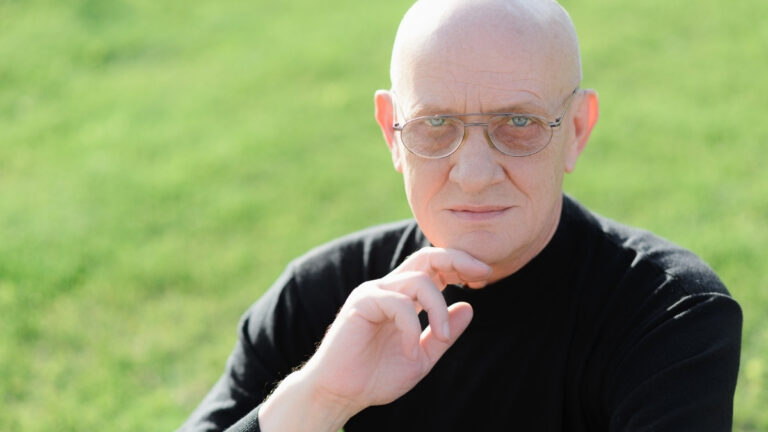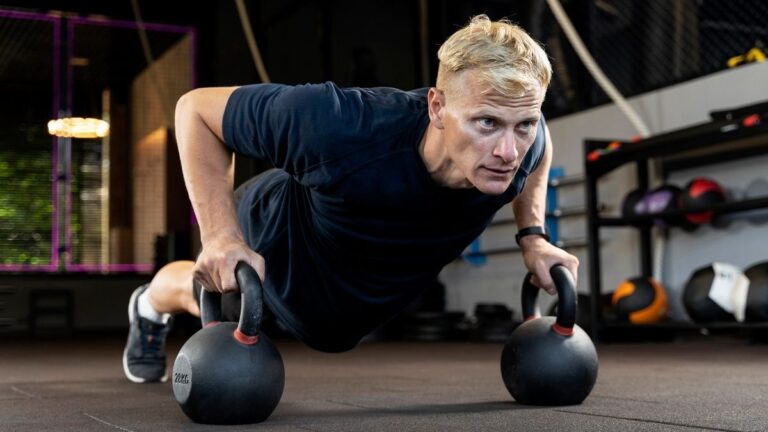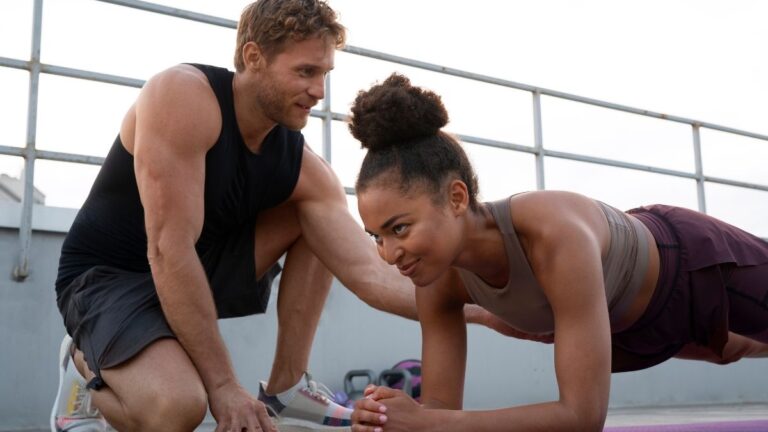See the Incredible 10-Week Transformation of This 75-Year-Old (Senior Fitness Miracle)
At 75, most people worry about maintaining their current health—but what if you could actually get stronger, leaner, and more energetic than you’ve been in decades?
Despite muscle mass naturally decreasing by 8-15% per decade after 40, and only 23.1% of adults 65+ meeting federal fitness guidelines, remarkable senior fitness transformation is absolutely possible.
This guide reveals elderly fitness success stories of 70+ year-olds who defied expectations, plus the exact 10-step framework for strength training for seniors over 70. You’ll discover science-backed nutrition, exercise, and recovery protocols for building muscle after 75—safely, regardless of your current fitness level.
The 10-Week Senior Transformation Timeline
Your roadmap from foundation to complete transformation
1-2
Foundation Building
Master proper form on basic exercises. Focus on bodyweight movements and building consistency. Your body begins adapting to new stimulus.
3-4
Strength Gains Begin
Introduce light weights and resistance. You’ll notice improved energy and better sleep. Muscles start responding to progressive overload.
5-6
Noticeable Changes
Clothes fit better, daily tasks become easier. Friends and family start commenting. This is when motivation soars!
7-8
Peak Performance
Significant strength increases. You’re lifting heavier, moving better, and feeling unstoppable. Mental clarity improves dramatically.
9-10
Transformation Complete
You’ve built a sustainable fitness lifestyle. Take progress photos, celebrate your achievement, and set new goals. You’re proof it’s never too late!
Complete Senior Fitness Checklist
Your daily and weekly essentials for optimal results
Strength Training
2x per week
Non-consecutive days, 30-45 minutes each sessionCardio Exercise
150 min weekly
Moderate intensity, can be split into 30-min sessionsDaily Protein
1.2-1.6g/kg
Spread evenly across 3 meals, 25-30g eachQuality Sleep
7-8 hours
Consistent bedtime, dark room, no screens before bedRest Days
48 hours
Between same muscle group workouts for recoveryHydration
8 glasses daily
More during exercise, monitor urine colorProtein Guide for Seniors
Fuel your muscles with the right amounts at the right times
📊 Daily Protein Calculator
Example: 68 kg × 1.4 = 95 grams per day
Best Protein Sources (30g serving)
🍗 Chicken Breast
4 oz cooked (palm-sized)
🐟 Salmon
5 oz cooked filet
🥚 Eggs
5 large eggs
🥛 Greek Yogurt
1.5 cups plain
🥤 Whey Protein
1 scoop powder
🫘 Lentils
2.5 cups cooked
⏰ Optimal Protein Distribution Throughout the Day
Safety First: When to Stop Exercising
Know the difference between good effort and dangerous symptoms
STOP IMMEDIATELY – Emergency Signs
- Chest pain or pressure
- Irregular, rapid, or fluttery heartbeat
- Severe shortness of breath
- Dizziness or feeling faint
- Sudden severe headache
- Vision changes or blurred vision
Warning Signs – Take a Break
- Unusual joint pain or swelling
- Excessive muscle soreness (3+ days)
- Persistent fatigue despite rest
- Nausea during exercise
- Sharp pain in specific area
- Coordination problems
Normal Exercise Sensations
- Muscle burn during exercise
- Mild soreness 1-2 days later
- Increased breathing rate
- Sweating and warmth
- Slight fatigue after workout
- Feeling energized overall
You’re tired of doctors adding another pill to your daily routine. Your knees hurt when you climb stairs. You can’t lift your grandkids anymore. And everyone keeps telling you “that’s just what happens when you get older.”
They’re wrong.
Here’s what nobody tells you: The difference between aging and aging well isn’t about your genes. It’s about what you do today.
This guide shows you exactly how to build muscle, lose weight, and get stronger after 75. No gym membership required. No complicated meal plans. Just real science and real people who’ve done it.
Let’s fix this.
What Your Doctor Isn’t Telling You About Fitness After 75
About 30% of adults over 70 struggle with basic stuff. Walking. Getting out of chairs. Climbing stairs.
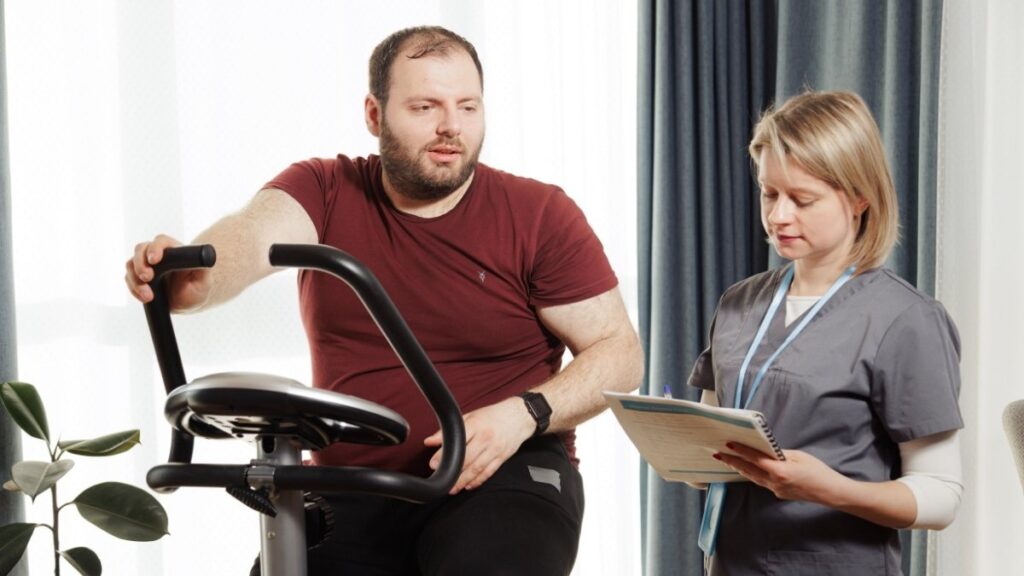
But here’s the truth that changes everything: Even in your late 80s, your body can still build muscle.
Not “maintain” muscle. BUILD it.
A 2025 study looked at 37 research papers from 13 countries. The finding? Strength training beats everything else for keeping your brain sharp as you age. Better memory. Faster thinking. Clearer focus.
And your heart? Just 60 minutes of lifting weights each week cuts your risk of dying from heart disease by 19%.
Women start losing muscle power slowly after 65. Men after 70. But here’s the catch—an active lifestyle slows this down so much it barely matters.
Physical activity reduces your risk of dying early. It protects you from heart disease, diabetes, and falls. It makes your mental health better. It keeps your mind working.
The gap between “I’m getting old” and “I’m aging like fine wine” comes down to one thing: what you choose to do.
Your Action Plan Starts Here:
Get checked out. Visit your doctor before you start. Ask about a body composition scan so you can track real progress, not just what the scale says.
Stop saying “I’m too old.” Start saying “My body can still get stronger.” Because it can.
Track where you are right now. Take photos. Write down how many stairs you can climb. Note how many grocery bags you can carry. You’ll want to see how far you’ve come.
Write down why this matters. Your grandkids? Travel? Living without pain? Getting off medications? Put it on paper. You’ll need it on hard days.
Find people doing this with you. Research shows you’ll stick with it way better when you’re not alone.
How Joan Lost 60+ Pounds and Became a Fitness Star at 75
At 70, Joan MacDonald was done. Her arthritis hurt all the time. Stairs made her exhausted. Her blood pressure kept climbing. Her doctor kept adding medications. She wasn’t living. She was just existing.
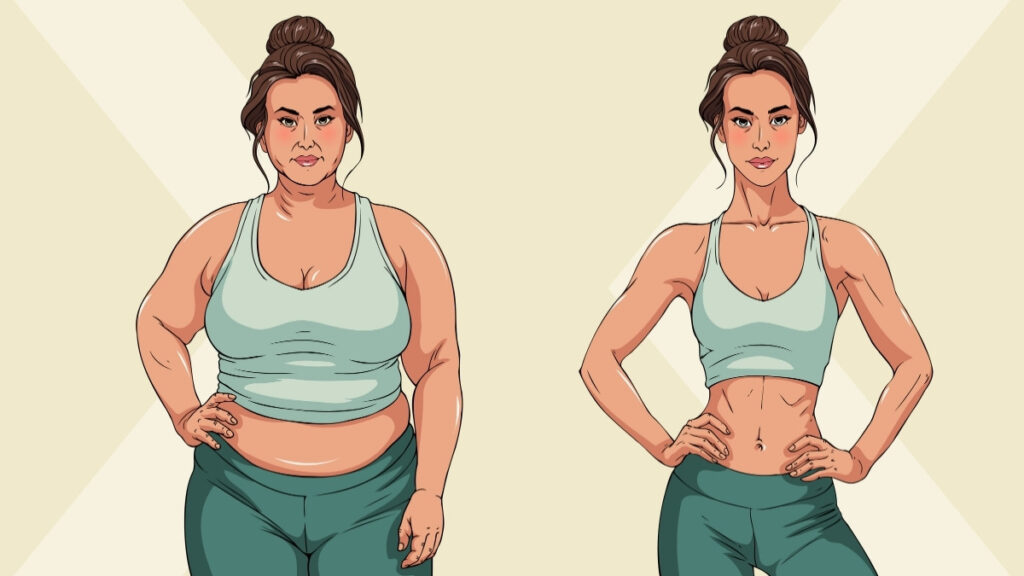
Her daughter, a fitness coach, gave her a choice: Change your life or watch your health fall apart. Joan chose change. Five years later, at 75, she’s lost over 60 pounds. She has 1.5 million people following her fitness story on Instagram. And she’s off most of her medications.
“I was sick and tired of being sick and tired,” Joan says. “It was existing, not living.”
She didn’t follow some magic program. She started small. She stayed consistent. She chose progress over perfection.
What You Can Learn From Joan:
Find your breaking point. What are you done tolerating? The pain? The pills? Not being able to play with your grandkids? Use that feeling as fuel.
Get help from people who know senior fitness. Generic workout plans don’t work. You need someone who gets what works for bodies like yours.
Take photos and measurements now. When you feel like nothing’s changing, these prove you wrong. They keep you going when motivation drops.
Find someone to keep you accountable. A friend. A coach. An online group. People who check in and ask “Did you do it today?”
Celebrate the stuff scales can’t measure. Stairs got easier? Your knee stopped hurting? You slept through the night? That’s winning.
Why Lifting Weights Is the Best Thing You Can Do After 75
The CDC says you need to strength train at least twice a week. Different days. Give your muscles a break between sessions.
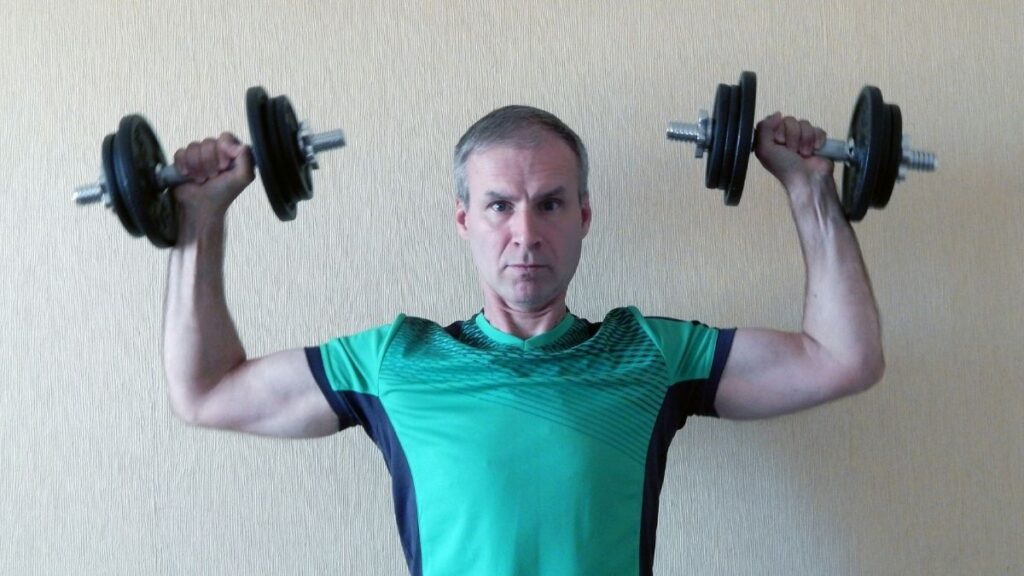
You don’t need heavy weights to build muscle. Anywhere from 6 to 15 repetitions works great for seniors. It builds strength without beating you up.
Start with your own body weight. Squats. Wall push-ups. Leg raises from a chair. Once you can do 3 sets of 10-15 reps easily, add weight.
Research shows training at 60-85% of your max builds muscle mass. Going harder—above 85%—makes you faster and more powerful.
Focus on movements you actually do in real life. Squatting. Pushing. Pulling. Standing up. These keep you independent.
Ilene Block was 61 when she started. In one year, she went from squatting 75 pounds to almost 130 pounds. Her hip thrusts hit 300 pounds.
She didn’t have special genes. She just showed up and did the work.
Here’s How to Start Lifting Safely:
Get really good at bodyweight exercises first. Perfect your squat form. Master wall push-ups. Hold planks correctly. Don’t touch weights until these feel easy.
Wait 2-3 days before training the same muscles again. Your body needs 48-72 hours to recover and get stronger. This isn’t being lazy. It’s being smart.
Train your legs more than anything. Strong legs prevent falls. They keep you independent. They let you live your life.
Add weight slowly. When your current weight feels manageable for all your reps, increase by 5-10%. Not more. Small jumps prevent injuries.
Pay for a trainer at first. Even just 3-5 sessions teach you proper form. They push you harder than you’d push yourself. And they keep you safe while you learn.
The Protein Secret That Changes Everything
Almost half of adults over 51 don’t eat enough protein. That’s 46% of people making muscle-building way harder than it needs to be.
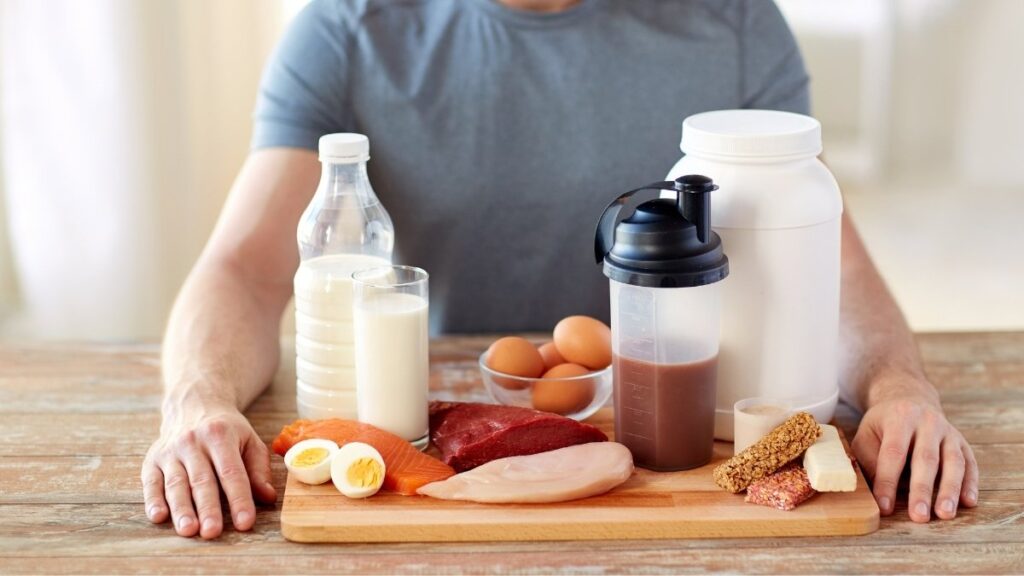
Your body needs at least 1.2 grams of protein for every kilogram you weigh. Every single day. For building muscle, 1.2 to 1.6 grams per kilogram works even better.
Spread it out. Your body can only use about 25-30 grams at once. Loading up at dinner doesn’t work. You need protein at every meal.
Whey protein beats plant protein for building muscle in older adults. It’s not even close.
And here’s what really works: Protein plus strength training. Together, they build more muscle and strength than either one alone.
Let’s make this simple. If you weigh 150 pounds (68 kg), you need 82-109 grams of protein daily.
What does that look like? Greek yogurt with nuts gives you 20 grams. A chicken breast gets you 30 grams. Salmon with quinoa hits 35 grams.
How to Get Enough Protein Every Day:
Do the math. Take your weight in kilograms. Multiply by 1.2 to 1.6. That’s your daily target.
Don’t save it all for dinner. Aim for 25-30 grams at breakfast, lunch, and dinner. Your muscles need steady fuel.
Choose quality. Lean meats. Fish. Eggs. Dairy. Beans. Lentils. These work better than processed protein.
Use protein powder if you need it. Whey protein helps when whole foods don’t get you there. But food comes first.
Eat protein within 2 hours after working out. That’s when your muscles are hungry and ready to grow.
Why Rest Days Matter More Than You Think
Your muscles recover slower now than when you were 30. That’s just biology. But it doesn’t mean you can’t build muscle. It means you need to be smarter.
Older bodies need more time to repair muscle and calm down inflammation after exercise. That’s not weakness. That’s your body doing important work.

Give yourself at least 48 hours before training the same muscles again. This isn’t optional. This is how you get stronger.
You need 7-8 hours of sleep every night. Not 5. Not 6. Seven to eight. That’s when your body heals and builds muscle.
Here’s something that surprises people: Training muscles twice a week works just as well as three times for older adults. Especially when you’re starting out.
And rest doesn’t mean lying on the couch all day. Light movement helps you heal faster than doing nothing.
Swimming. Gentle yoga. Easy walks. These keep blood flowing to your muscles without wearing them down.
How to Recover Like a Pro:
Mark rest days on your calendar. Treat them as important as workout days. Because they are.
Move lightly on rest days. Try gentle yoga, tai chi, or walking. Your blood flow increases without straining your muscles.
Make your bedroom perfect for sleep. Dark. Cool. No phone for an hour before bed. Consistent bedtime every night.
Listen to what your body tells you. Sore for days? Can’t sleep? Not getting stronger? Bad mood? You need more rest.
Keep a simple journal. Write down how you slept. Your energy level. Your mood. You’ll spot patterns that help you recover better.
How to Protect Your Heart While Building Muscle
Experts say you need 30 minutes of moderate exercise five days a week. Walking counts. Swimming counts. Biking counts. Dancing counts.

Physical activity cuts your risk of heart disease and high blood pressure.
Here’s something wild: At 70, proper training can give you the cardiovascular fitness of an elite athlete.
Walking 8,000-10,000 steps daily makes a huge difference in your health. You don’t need to run marathons.
Mix it up. Walking gets boring. Try swimming one day. Bike the next. Take a dance class. Your heart doesn’t care which one you pick.
Charlene took circuit training classes three times a week. At 71, she ran a mile in 7 minutes.
Doris Estes is 81. She started working out after falling during the pandemic. She just won a 5K race in her age group.
Your Cardio Game Plan:
Start with walking. Build up to 30 minutes a day before you make it harder. Walk before you run.
Use the talk test. If you can talk but not sing, that’s moderate intensity. If you can only say a few words without stopping to breathe, that’s vigorous.
Try intervals during walks. Go easy for 2 minutes. Go harder for 1 minute. Repeat. This builds fitness faster than steady pace.
Join a group class. SilverSneakers. Water aerobics. Senior fitness groups. Other people make it more fun and keep you showing up.
Count your steps. Use your phone or a cheap pedometer. Seeing the number go up motivates you to move more.
The Fall Prevention Exercises That Save Lives
Regular exercise makes your bones stronger. It improves your balance. It cuts your risk of falling.
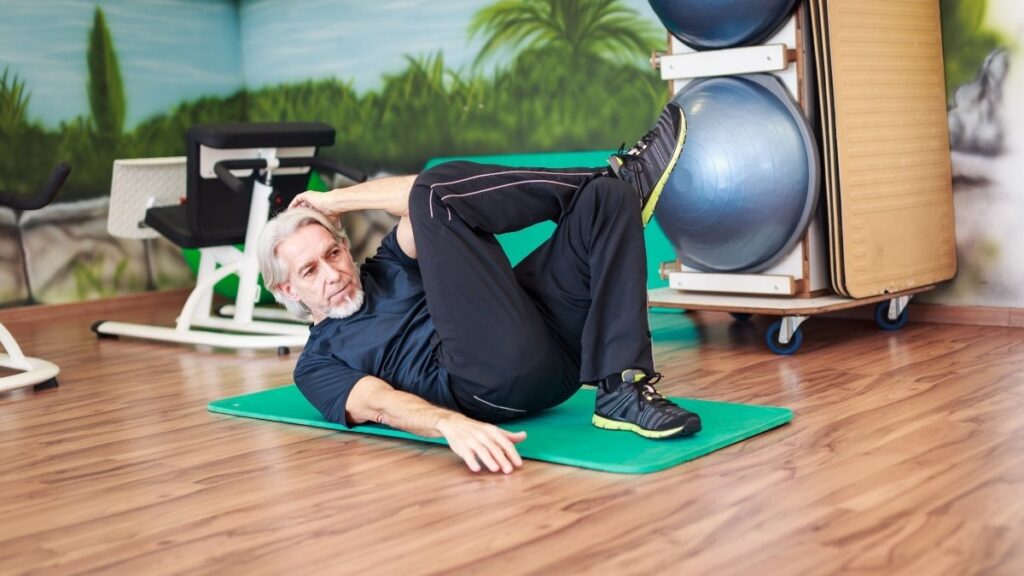
About 30% of adults over 70 have trouble moving around. But balance exercises can fix this.
You should practice balance moves 2-3 times every week.
Stretching gives you more flexibility and prevents injuries.
Here’s what matters more than looking good: Being able to live your life. Functional fitness beats gym selfies every single time.
Try standing on one leg. Walk heel-to-toe in a straight line. Do tree pose from yoga.
Chair yoga works. Tai chi works. Simple stretching routines work.
A 62-year-old woman started taking a 75-minute yoga class every day. It transformed her body and how she thought about food.
Balance and Flexibility Tricks:
Practice balance while brushing your teeth. Stand on one foot. Hold the counter if you need to. Two minutes twice a day adds up.
Try yoga or tai chi classes. They’re designed for balance, flexibility, and calm minds.
Stretch after you work out. Hold each stretch for 20-30 seconds. Your muscles are warm and ready to lengthen.
Practice real-life movements. Get up from the floor. Reach overhead. Turn to look behind you. These keep you independent.
Make your home safer while you get stronger. Clear clutter. Add grab bars in the bathroom. Better lighting. Don’t wait for a fall to fix hazards.
How to Fix the Voice in Your Head That Says “I’m Too Old”
A lot of women over 50 believe lies. “I’m too old.” “I’ll get hurt.” “It’s too late for me.” All lies. Joan MacDonald’s words changed her life: “I was sick and tired of being sick and tired. It was existing, not living.”
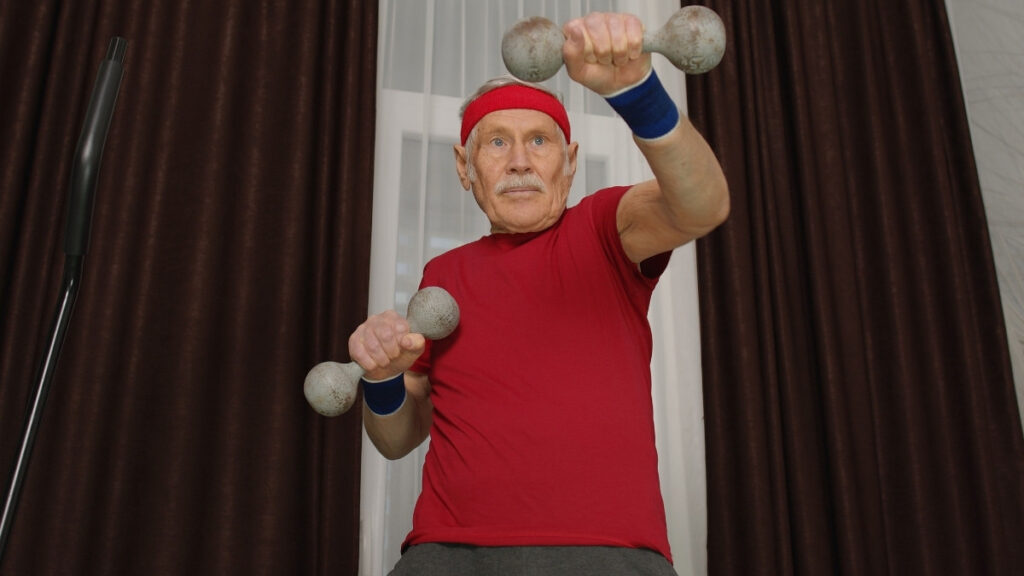
Having people around you who get it makes all the difference. Accountability groups work.
Stop focusing on how you look. Focus on what you can do. That’s what keeps you going.
And forget about getting “bulky.” That’s not how women’s bodies work. You’re going to get strong. That’s the point.
Ilene Block doesn’t always feel like working out. “But I made a promise to myself to always start a workout,” she says. Once you start, you usually finish. Don’t obsess over the scale. It lies. How you feel matters more.
Mind Tricks That Actually Work:
Change your words. Stop saying “I can’t.” Start saying “I’m learning to” or “Not yet.”
Find your people. Online groups like The Wonder Women connect women doing this together. Local senior fitness groups work too.
Set goals about actions, not results. “Work out 3 times this week” beats “lose 10 pounds.” You control actions. Results take time.
Spend 5 minutes every day imagining your strong future. See yourself pain-free. Active. Lifting your grandkids. Make it vivid.
Celebrate tiny wins. You did all three workouts this week? Ring a bell. Tell a friend. Buy yourself flowers. Make it feel good to keep promises to yourself.
The Vitamins and Supplements That Actually Help
More than 40% of Americans don’t get enough vitamin D. You need it for strong bones and muscles.
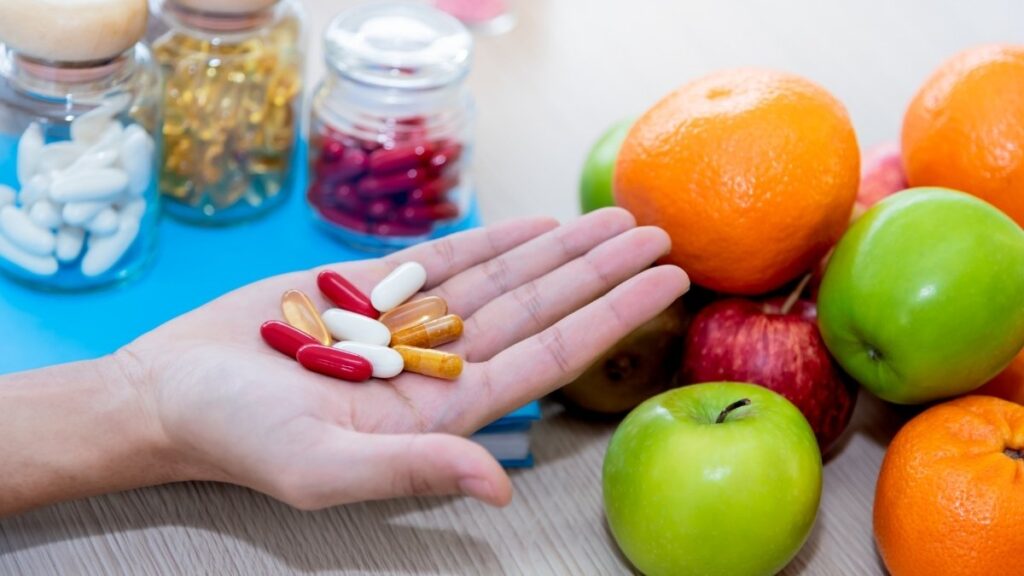
Creatine builds muscle mass and strength. It helps you perform better during exercise. And it’s good for your brain as you age.
Your thirst sensation decreases as you get older. But your body still needs just as much water. Don’t wait until you feel thirsty. Foods that fight inflammation help you recover faster from workouts. Antioxidants from food reduce inflammation and speed up muscle repair.
Take 5 grams of creatine monohydrate every day. Doesn’t matter when. Just take it.
Eat leafy greens, berries, fatty fish, and nuts for faster recovery.
Simple Supplement Strategy:
Drink 8 glasses of water every day. Check your pee. Pale yellow means you’re good. Dark yellow means drink more.
Consider creatine. It’s safe. It’s cheap. Hundreds of studies prove it works for older adults.
Get your vitamin D checked. Ask your doctor for a blood test. If you’re below 30 ng/mL, you need supplements.
Eat colorful foods. Different colors mean different antioxidants. Your body needs variety.
Cut processed junk. Focus on real, whole foods. They reduce inflammation naturally.
Your Exact 10-Week Plan to Transform Your Body
Science shows a 12-week program designed for women over 50 creates real changes.
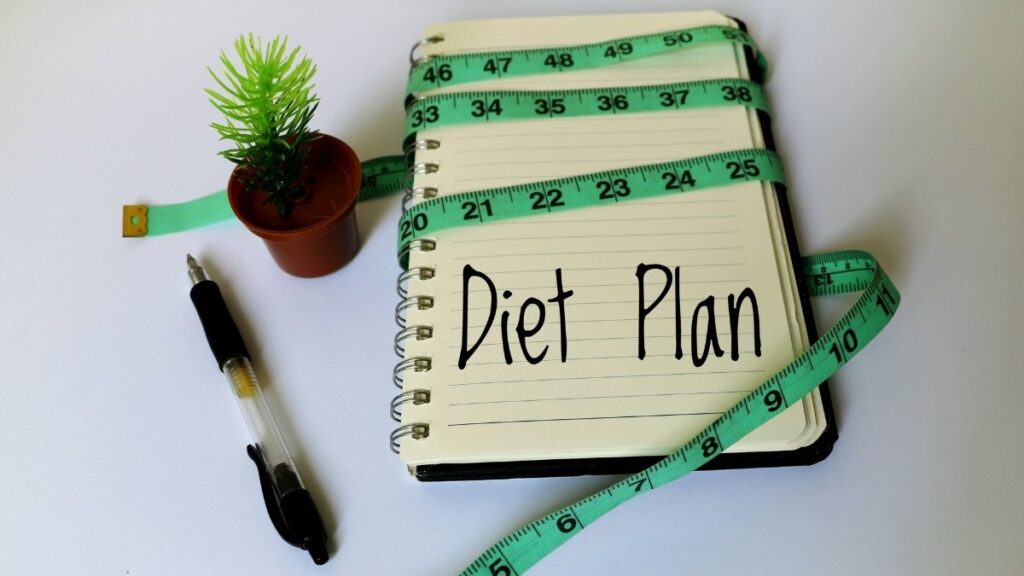
Here’s how to structure your transformation:
Weeks 1-2: Learn perfect form. Don’t worry about weight yet. Master the movements.
Weeks 3-6: Start adding weight gradually. This is where muscle-building begins.
Weeks 7-10: You’re hitting peak strength and conditioning. This is where you see the biggest changes.
Most people notice and feel body changes within a week of starting.
Your weekly schedule: 2 days of strength training. 3-5 days of cardio. 2 days of active recovery.
Bryan Krahn, a fitness expert, says consistency beats perfection. Miss a day? Start again tomorrow. Don’t quit because you weren’t perfect.
Your Week-by-Week Playbook:
Weeks 1-2: Focus only on learning these 5 exercises perfectly: squat, push-up, row, plank, deadlift. No weight. Just form.
Track everything. Get a notebook. Write down what you did. How it felt. What weight you used. This keeps you honest and shows progress.
Increase weight slowly. When something feels easy, add a little more. Not a lot more. A little.
Put it on your calendar. Write “Strength Training 9am Tuesday” like it’s a doctor’s appointment. Find what time of day works best for you.
Move at your pace. If a class goes too fast, slow down. Stay connected to what your muscles are doing. That mind-muscle connection matters more than speed.
How to Stay Safe and Avoid Injuries
Talk to your doctor before you start. Especially if you haven’t exercised in a while or you have health conditions.

Here’s good news: The idea that older adults should train lightly to avoid injury is wrong. Research doesn’t support it. You can train hard safely.
You might need to modify exercises for arthritis, weak bones, or heart conditions. That’s fine. Modifications still build strength.
Stop immediately if you get these warning signs: Swollen or painful muscles or joints. Chest pain. Can’t catch your breath. Dizziness.
Physical therapists and specialized trainers know how to work with older adults safely.
Patricia Jenkins had knee problems. She saw a physical therapist first. Fixed the issues. Then started strength training without pain.
Safety First Checklist:
Get medical clearance. Take this article to your doctor. Talk about your plans. Get the green light.
Start lighter than you think you need. Pick a weight that feels comfortable for all your reps. You can always add more later.
Learn form before you add weight. Hire a certified senior fitness trainer for 3-5 sessions. It’s worth every penny.
Know the stop signals. Chest pain? Irregular heartbeat? Shortness of breath? Stop working out immediately and call your doctor.
Tell your trainer everything. Your medical conditions. Your medications. Where you feel pain. Don’t hide anything. It keeps you safe.
How to Keep Your Results Forever
Fitness isn’t a 10-week project. It’s how you live now. You can hit your goals at any age. And then you set new ones. Joan MacDonald says it perfectly: “Nothing is magical. It’s work, but it’s work that you can enjoy.”
Long-term success comes from strategies that fit your real life.
Finding movement that makes you feel joyful and strong beats forcing yourself to do stuff you hate.
You’ll have setbacks. You’ll get sick. You’ll travel. You’ll miss workouts. That’s life. What matters is coming back. Liz Hilliard is 70. She lifts weights at least 4 times a week. Not just for her body. For her emotions. For her mind. For her whole life.
How to Make This Stick Forever:
Find activities you actually enjoy. Try different classes. Barre. Strength training. Dancing. Water aerobics. When you like it, you’ll keep doing it.
Build your support crew. Join The Wonder Women or a local senior fitness group. Having people who get it makes the difference between quitting and thriving.
Plan for disruptions. Have a 15-minute home workout ready. When you travel or get sick, you don’t stop completely. You just adjust.
Reward yourself at milestones. Hit 3 months? Buy new workout clothes. Six months? Get a massage. One year? Celebrate at your favorite restaurant.
Keep setting new goals. After you transform, what’s next? A 5K race? Heavier weights? Learning a new skill? Always have something to work toward.
Your Transformation Starts Now
The science is clear. You can build muscle after 75. You can lose weight. You can get stronger.
Joan did it. Marilynn did it. Charlene did it. Thousands of others have done it. You can too. This 10-step plan gives you everything you need. The workouts. The nutrition. The recovery. The mindset. The safety guidelines. The long-term strategy.
Real people prove it works. Science backs it up. Now it’s your turn.
Start today. Not Monday. Not next month. Today.
Pick one thing from this guide. Schedule a doctor’s appointment. Join a senior fitness class. Take a 10-minute walk around your block.

